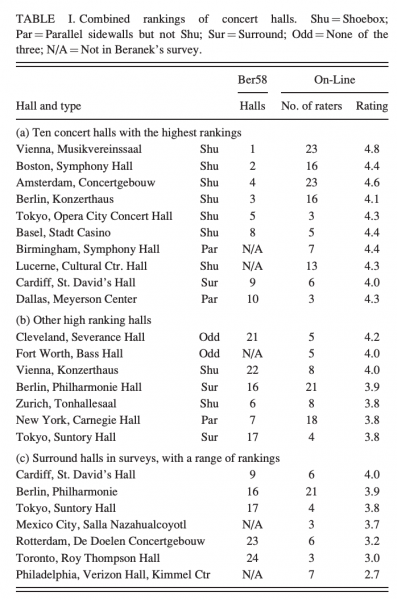I ran into the following the other day https://www.researchgate.net/figure...hallow-with-sloping-side-walls_fig2_267257492

Boston Symphony Hall. The stage house is high, wide, and shallow, with sloping side walls and ceiling. Reflections from these surfaces are directed into the hall, and multiple reflections do not occur within the stage house. Instruments in the rear of the orchestra have equal clarity as instruments in front. Notice the coffers on the ceiling, and the niches along the side walls.
Followed by this https://www.researchgate.net/figure...ny-Hall-with-occupied-hall-and_fig6_267257492

50ms window-integrated impulse response of Boston Symphony Hall with occupied hall and stage, 1000Hz octave band. The source was in the middle of the violin section, the receiver was in the front of the first balcony-nearly 100ft from the source. Note the clear double slope. The RT for the first 10dB of decay is 1.0 seconds. The RT of the later decay is 1.9 seconds. The side wall and ceiling reflections have been significantly attenuated at this frequency. This is Leo Beranek's favorite seat. It provides excellent localization, engagement, and envelopment.
QUESTION: What is this analysis saying? What's a "window-integrated" impulse response? What's RT (round trip?) in this context? What does this say about the sound at Symphony Hall?
AND THEN: A local audiophile sent the following old article from Robert E Green http://www.regonaudio.com/Records and Reality.html which says (and I agree)
Anyone have FR graphs for Symphony Hall or other halls? REG's claims feel a little arbitrary without references to at least a few halls...
-ack

Boston Symphony Hall. The stage house is high, wide, and shallow, with sloping side walls and ceiling. Reflections from these surfaces are directed into the hall, and multiple reflections do not occur within the stage house. Instruments in the rear of the orchestra have equal clarity as instruments in front. Notice the coffers on the ceiling, and the niches along the side walls.
Followed by this https://www.researchgate.net/figure...ny-Hall-with-occupied-hall-and_fig6_267257492

50ms window-integrated impulse response of Boston Symphony Hall with occupied hall and stage, 1000Hz octave band. The source was in the middle of the violin section, the receiver was in the front of the first balcony-nearly 100ft from the source. Note the clear double slope. The RT for the first 10dB of decay is 1.0 seconds. The RT of the later decay is 1.9 seconds. The side wall and ceiling reflections have been significantly attenuated at this frequency. This is Leo Beranek's favorite seat. It provides excellent localization, engagement, and envelopment.
QUESTION: What is this analysis saying? What's a "window-integrated" impulse response? What's RT (round trip?) in this context? What does this say about the sound at Symphony Hall?
AND THEN: A local audiophile sent the following old article from Robert E Green http://www.regonaudio.com/Records and Reality.html which says (and I agree)
Right from the beginning, there is this difference between what is recorded and what you would hear if you were at the performance: Almost all records are made with the microphones closer to the performers than the audience would be. The sound very close to the performers is also an aspect of the absolute sound of live music. But the sound that the composer and the performers intend for us to hear is the sound at audience locations, and the sound the audience would hear is presumably what we should be trying to hear at home from our audio systems.
Close-up and distant sounds differ in the relative amounts of direct and reflected sound. There 'is also an important difference in the spectral balance-that is, the relative prominence of the various frequency ranges. At first sight, it may not be clear why an increase in the distance should be associated to changes in balance. But these changes do.occur and, in fact, are substantial. The reason for and extent of these shifts in spectral balance are what I want to explain here as well I can.
...
The graphs show considerable variety from hall to hall in bass and mid-bass response, with the halls that are regarded as desirable for orchestral performances having considerable bass to mid-bass warmth. A less desirable feature of many halls is a slight 250 Hz depression, apparently caused by absorption arising from the seating pattern. In the midrange above 250 Hz up to the 2-4 kHz region, most of the halls are essentially flat. But around 4000 Hz, and sometimes as low as 2000 Hz, virtually every hall begins a rapid roll-off at even quite close-up audience locations. By 8000 Hz, there is typically a 7 to 10 dB dropoff from midrange level. The graphs are not given beyond 8 kHz; but from theoretical considerations, the roll-off at higher frequencies would be expected to be even greater.
Anyone have FR graphs for Symphony Hall or other halls? REG's claims feel a little arbitrary without references to at least a few halls...
-ack
Last edited:







